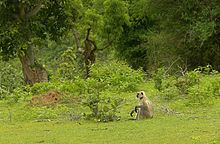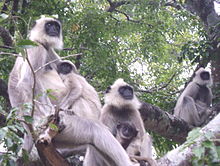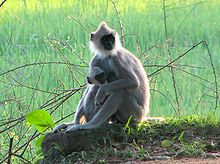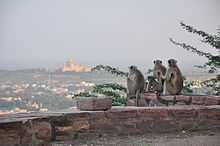- Gray langur
-
Gray langur[1] Alpha male langur Scientific classification Kingdom: Animalia Phylum: Chordata Class: Mammalia Order: Primates Family: Cercopithecidae Subfamily: Colobinae Genus: Semnopithecus
Desmarest, 1822Type species Simia entellus
Dufresne, 1797Species Semnopithecus schistaceus
Semnopithecus ajax
Semnopithecus hector
Semnopithecus entellus
Semnopithecus hypoleucos
Semnopithecus dussumieri
Semnopithecus priam
Rough distribution of the genus Gray langurs or Hanuman langurs, the most widespread langurs of South Asia, are a group of Old World monkeys constituting the entirety of the genus Semnopithecus. All taxa have traditionally been placed in the single species Semnopithecus entellus.[1] In 2001, it was recommended that several distinctive former subspecies should be given full species status, so that seven species are recognized.[2] A taxonomic classification with fewer species has also been proposed.[3] Genetic evidence suggests that the Nilgiri langur and purple-faced langur, which usually are placed in the genus Trachypithecus, actually belong in Semnopithecus.[4]
Gray langurs are large and fairly terrestrial, inhabiting forest, open lightly wooded habitats, and urban areas on the Indian subcontinent. Most species are found at low to moderate altitudes, but the Nepal gray langur and Kashmir gray langur occur up to 4,000 metres (13,000 ft) in the Himalayas.[5][6]
"Hanuman" refers to the Hindu deity Hanuman.
Contents
Characteristics
These langurs are largely gray (some more yellowish), with a black face and ears. Externally the various species mainly differ in the darkness of the hands and feet, the overall color and the presence or absence of a crest.[2][3] There are also significant variations in the size depending on the species, but the head-and-body length of males is typically up to 75 cm (30 in) and that of females is 65 cm (26 in). Their tail is always longer than their body. Langurs from the southern part of their range are smaller than those from the north. At 26.5 kg (58 lb), the heaviest langur ever recorded was a male Nepal gray langur.[3]
Langurs mostly walk quadrupedally and spend half their time on and the ground and the other half in the trees.[7] They will also make bipedal hops, climbing and descending supports with the body upright, and leaps. [7] Langurs can leap 3.7-4.6 m (12.0-15.0 ft) horizontally and 10.7-12.2 m (35-40 ft) in descending.[7]
Taxonomy
Traditionally, only Semnopithecus entellus was recognized as a species, the remainder all being treated as subspecies. In 2001, it was proposed that seven species should be recognized, with the majority considered monotypic.[2] This was followed in Mammal Species of the World in 2005,[1] though several of the seven species intergrade, and alternative treatments exist where only two species (a northern and a southern) are recognized.[3] Phylogenetic evidence supports at least three species (a north Indian, a south Indian and a Sri Lankan species).[4] It has also been suggested that Semnopithecus priam thersites is worthy of treatment as a species rather than a subspecies, but at present this is based on limited evidence.[8]
It has been suggested that Trachypithecus should be considered only a subgenus of Semnopithecus.[3] If maintaining the two as separate monophyletic genera, the purple-faced langur and Nilgiri langur belong in Semnopithecus instead of the usual Trachypithecus.[4] At present it is unclear where the T. pileatus species group (consisting of the capped langur, Shortridge's langur and Gee's golden langur) belongs, as available mtDNA data place it in Semnopithecus, while Y chromosome data place it in Trachypithecus.[4]
The seven species of Semnopithecus recognized in Mammal Species of the World are:[1]
- Nepal gray langur Semnopithecus schistaceus
- Kashmir gray langur Semnopithecus ajax
- Tarai gray langur Semnopithecus hector
- Northern plains gray langur Semnopithecus entellus
- Black-footed gray langur Semnopithecus hypoleucos
- Southern plains gray langur Semnopithecus dussumieri
- Tufted gray langur Semnopithecus priam
Distribution and habitat
 Langur near Bandhavgarh National Park
Langur near Bandhavgarh National Park
They range from Kashmir in north India and the Nepalese, Bhutanese, and Tibetan Himalayas, east to Bangladesh and west to Pakistan’s Indus Valley.[9] They possibly occur in Afghanistan.[3]
Gray langurs can adapt to a variety of habitats.[10] They inhabit arid habitats such as desert areas, dry open scrub, dry deciduous forests, but also tropical and subtropical evergreen rainforests, moist deciduous forest, broadleaf forest, subtropical pine forest, riverine forest, open park woods, mountain foothills, mountain forests, Himalayan oak-coniferous forests, temperate coniferous forest, sub-alpine forest, grasslands, meadows, scrub, scrub forests, and mixed grasslands. They live at altitudes up to 4,000 m (13,000 ft) including areas that receive snowfall in the winter. They can adapt well to human settlements, and are found in villages, towns, residential areas, tourist areas, temple grounds, orchards and cultivated areas.[11] They live in densely populated cities like Jodhpur, which has over a million inhabitants.[12]
Ecology and behavior
Gray langurs are diurnal. They sleep during the night in trees or hunting towers or high-tension electric poles when in human settlements.[13] When resting in trees, they generally prefer the highest branches.[14]
Ungulates like bovine and deer will eat food dropped by foraging langurs.[15] Langurs are preyed upon by leopards, dholes and tigers.[16] Wolves, jackals and pythons may also prey on langurs.
Diet
Gray langurs are primarily herbivores. However, unlike some other colobines they do not exclusively eat leaves and leaf buds of herbs, but also coniferous needles and cones, fruits and fruit buds, evergreen petioles, shoots and roots, seeds, grass, bamboo, fern rhizomes, mosses, and lichens. Leaves of trees and shrubs rank top of their preferred food, followed by herbs and grasses. Non-plant material consumed include spider webs, termite mounds and even cremated human remains. They forage on agricultural crops and other human foods, and even accept handouts.[17] Although they occasionally drink, langurs get most of their water from the moisture in their food.[18]
Social structure
Gray langur family at Mudumalai National Park
Gray langurs exist in three types of groups:
- uni-male groups, comprising one adult male, several females and offspring;
- multi-male groups, comprising males and females of all ages;
- all male groups.[19][20]
All-male groups tend to be the smallest of the groups and can consist of adults, sub-adults, and juveniles. There are some populations that have only multi-male groups as mixed sex groups while others have only uni-male groups as mixed sexed groups.[19]
Some evidence suggests that multi-male groups are temporary and exist only in the transition period following a takeover during the mating season and soon split into uni-male and all-male groups.[21]
Social hierarchies exist for all group types.[22][23] In all-male groups, dominance is attained by displacing another member, chasing, fighting, copulatory success, and harassment.[24] With sexually mature females, rank is based on physical condition and age.[25][26] The youngest females rank highest and they drop in rank as they age. Aggressive and submissive interactions occur more often between high-ranking individuals in a group.[23] Most changes in social rank in males are associated with emigration and immigration. An adult male may remain in a uni-male group for 45 months.[27] The rate of male replacement can occur quickly or slowly depending on the group.[28]
Females within a group are matrilineally related. Female memberships are also stable, but less so in larger groups.[25][20] Relationships between the females tend to be friendly. They will eat, move and rest together and embrace, and greet each other. They will also groom amongst themselves with grooming directed both up and down the dominance hierarchy. However higher-ranking females give out and receive grooming more than lower ranking females.[29] In addition, females groom males more than the other way around.[30] Males and females in a group tend to be calm and cooperative. Relationships between males can range from peaceful and cooperative to agonistic. While females remain in their natal groups, males will leave when they reach adulthood.[20] Relationships between groups tend to be agonistic. High-ranking males from different groups will display, vocalize, and fight among themselves.
Reproduction and parenting
In uni-male groups, the resident male is usually the sole breeder of the females and sires all the young. In multi-male groups, the highest ranking male fathers most of the offspring followed by the next ranking males and even outside males will father young.[31]
Higher ranking females are more reproductively successful than lower ranking ones. They will mate both polygynously and polygamously.[26]
Female grey langurs show no external sign that they are in a reproductive state. However, males seem to be able to deduce the reproduction state of female though some unknown means.[32] Females will solicit copulation by shuddering the head, lowering the tail, and presenting the anogenital region.[33] Solicitations are not always successful in achieving a copulation. When langurs mate, they are sometimes harassed by other group members.[27] Females have even been recorded mounting other females.[34]
The gestation period of grey langur lasts around 200 days, at least at Jodhpur, India. In some areas, reproduction is year-around.[33] It appears that year-round reproduction occurs in populations that capitalize on human made foods. Other population have seasonal reproduction.[27]
Infanticide is common among gray langurs. Most infanticidal langurs are males that have recently immigrated to a group and driven out the prior male. These males only kill infants that are not their own.[35] Infanticide is more commonly reported in uni-male groups, possibly because situations where one male breeds drive the evolution of this trait. In multi-male groups, the costs for infanticidal males are likely to be high as other resident males might defend the victim, and the benefits may be low due to the lower parental probability in multi-male groups. Nevertheless, infanticide does occur in these groups, and is suggested to be a male reproductive strategy intended to shorten the female’s interbirth interval and sire her next offspring.[36]
Females usually give birth to a single infant, although twins do occur. Most births occur during the night.[37] Infants are born with thin dark brown or black hair and pale skin. Infants spend their first week clinging to their mothers’ chest and suckling, or sleeping.[38] They do not move much in terms of locomotion for the first two week of their life. As they approach their sixth week of life, infants vocalize more.[39]
They use squeaks and shrieks to communicate stress. In the following months, the infants are capable of quadrupedal locomotion and can walk, run and jump by the second and third months. Alloparenting occurs among langurs, starting when the infants reach two years of age. The infant will be transferred among the group females. However if the mother dies, the infant usually follows.[38] Langurs are weaned by 13 months.
Vocalizations
Gray langurs are recorded to make a number of vocalizations.[40][41]
- lough calls or whoops made only by adult male during displays;
- harsh barks made by adult and subadult males when surprised by a predator;
- cough barks made by adult and subadult during group movements;
- grunt barks made mostly by adult males during group movements and agonistic interactions;
- rumble screams made in agonistic interactions;
- pant barks made in conjunction with loud calls during inter-group interactions;
- grunts made in many different situations, usually in agonistic ones;
- honks made by adult males during inter-group interactions;
- rumbles made during approaches, embraces, and mounts;
- hiccups made by most members of a group when another group is sighted.
Status and conservation
While many populations of gray langurs are stable, in some areas they are declining,[42] and both the black-footed gray langur and Kashmir gray langur are considered threatened.[6][43] The latter is the rarest species of gray langur with less than 250 mature individuals remaining.[6]
In India, langurs number at around 300,000.[44] India has laws prohibiting the capturing or killing of langurs. Enforcement of these laws have proven to be difficult and it seems most people don’t know they are protected.[45] The natural habitat of gray langurs is threatened by encroachment and plantation and slash-and-burn agriculture.[45] Other threats include open cast mining, fire damage, grazing, ground litter removal, and non-timber forest products including wood for fuel, fodder, fruits, gums, seeds, and medicinal plants.[46]
Langurs can be found near roads and can become victims of automobile accidents. This happens even in protected areas with deaths by automobile collisions making nearly a quarter of mortality in Kumbhalgarh Wildlife Sanctuary in Rajasthan, India.[47] Langurs are considered sacred in the Hindu religion and are sometimes kept for religious purposes by Hindu priests and for training for roadside performance.[48] However there are some groups of different religions that will hunt langurs for medical purposes and parts of gray langurs are sometimes kept as amulets and seen as having positive effects for the bearer.[48]
Because they are considered sacred and also due to their less aggressive behavior compared to other primates, langurs are generally not considered pests in many parts of India. Nevertheless, attitudes have somewhat changed partly due to secularization. Langurs will raid crops and steal food from houses and this causes people to persecute them.[49] People will feed them in temples, but treat the ones they find at home as a nuisance.[50] Langur stealing and biting people to get food in urban areas may also contribute to more persecutions.[51]
References
- ^ a b c d Groves, C. (2005). Wilson, D. E., & Reeder, D. M, eds. ed. Mammal Species of the World (3rd ed.). Baltimore: Johns Hopkins University Press. pp. 174–175. OCLC 62265494. ISBN 0-801-88221-4. http://www.bucknell.edu/msw3/browse.asp?id=12100693.
- ^ a b c Groves C. 2001. Primate taxonomy. Smithsonian Institution Press. ISBN 156098872X
- ^ a b c d e f Brandon-Jones, D. 2004. A taxonomic revision of the langurs and leaf monkeys (Primates: Colobinae) of South Asia. Zoos' Print Journal 19 (8): 1552–1594.
- ^ a b c d Osterholz, M., Walter, L. and Roos, C. (2008). "Phylogenetic position of the langur genera Semnopithecus and Trachypithecus among Asian colobines, and genus affiliations of their species groups". BMC Evolutionary Biology 8: 58. doi:10.1186/1471-2148-8-58. PMC 2268674. PMID 18298809. http://www.biomedcentral.com/1471-2148/8/58.
- ^ Kumar, A., Yongzu, Z., Molur, S. (2008). "Semnopithecus schistaceus". IUCN Red List of Threatened Species. Version 2010.4. International Union for Conservation of Nature. http://www.iucnredlist.org/apps/redlist/details/39840.
- ^ a b c Groves, C.P., Molur, S. (2008). "Semnopithecus ajax". IUCN Red List of Threatened Species. Version 2010.4. International Union for Conservation of Nature. http://www.iucnredlist.org/apps/redlist/details/39833.
- ^ a b c Ripley S. (1967) "The leaping of langurs: a problem in the study of locomotor adaptation". Am J Phys Anth 26:149-70.
- ^ Molur, S., Singh, M. & Kumar, A. (2008). "Semnopithecus priam". IUCN Red List of Threatened Species. Version 2010.4. International Union for Conservation of Nature. http://www.iucnredlist.org/apps/redlist/details/135440. Retrieved 16 November 2010.
- ^ Roonwal, M.L., Mohnot, S.M. (1977) Primates of South Asia: ecology, sociobiology, and behavior. Harvard University Press, Cambridge (MA)
- ^ Oppenheimer, J.R. (1977) "Presbytis entellus, the Hanuman langur". In: Rainier III (Grimaldi) Prince of Monaco, Bourne, G.H. (eds.) Primate conservation. New York: Academic Press
- ^ Bennett, E.L., Davies, A.G. (1994) "The ecology of Asian colobines". In: Davies, A.G., Oates, J.F. (eds.) Colobine monkeys: their ecology, behaviour and evolution. Cambridge University Press. Pp. 129–171.
- ^ Waite, T.A., Chhangani, A.K., Campbell, L.G., Rajpurohit, L.S., Mohonot, S.M. (2007) "Sanctuary in the city: urban monkeys buffered against catastrophic die-off during ENSO-related drought". EcoHealth 4(3): 278–286.
- ^ Sharma SK. (2002) "High-tension electric poles used as a night roost by troops of Hanuman langur Presbytes [sic] entellus at Nahargarh Wildlife Sanctuary, Jaipur. J Bombay" Nat Hist Soc 99(1):103.
- ^ Ramakrishnan U, Coss RG. (2001) "A comparison of the sleeping behavior of three sympatric primates". Folia Primatol 72(1):51-3.
- ^ Punekar, S.A. (2002) "Some food plants of Hanuman langur Semnopithecus entellus (Dufresne) in the western Ghats of Maharashtra, India". Zoos' Print Journal 17(6): 797–801.
- ^ Boggess, JE. (1976) "Social behavior of the Himalayan langur (Presbytis entellus) in eastern Nepal". PhD dissertation, University of California, Berkeley. 247 p.
- ^ Vogel, C. (1977) "Ecology and sociology of Presbytis entellus. In: Prasad, M.R.N., Anand Kumar, T.C. (eds.) Use of non-human primates in biomedical research. International Symposium held in New Delhi, India, November 1975. Indian National Science Academy, New Delhi. pp. 24–45.
- ^ Starin, E.D. (1978) "A preliminary investigation of home range use in the Gir Forest langur". Primates 19(3): 551–568.
- ^ a b Rajpurohit, L.S. (1992) "Origin and composition of the unisexual unit — an all-male band in Hanuman langur, Presbytis entellus, around Jodhpur, India". Prim Rep 34: 47–52.
- ^ a b c Newton P. (1994) "Social stability and change among forest Hanuman langurs (Presbytis entellus) ". Primates 35(4): 489–498.
- ^ Mathur, R., Manohar, B.R. (1990) "Density of Macaca mulatta and Presbytis entellus in the old city of Jaipur: a three year survey". Applied Animal Behaviour Science 27(4): 351–361.
- ^ Srivastava, A., Mohnot, S.M. (1992) "Existence of multimale troops and their transformation into unimale troops in Hanuman langurs". Prim Rep 34: 71–75.
- ^ a b Rajpurohit, D.S., Rajpurohit, L.S. (2005) "Displacement interactions-the determinants of dominance hierarchy in Hanuman langur, Semnopithecus entellus around Jodhpur (India)". Journal Adv Zoology 26(2): 64–68.
- ^ Rajpurohit, L.S., Chhangani, A.K., Rajpurohit, R.S., Bhaker, N.R., Rajpurohit, D.S., Sharma, G. (2008) "Recent observation on resident male change followed by infanticide in Hanuman langurs (Semnopithecus entellus) around Jodhpur". Prim Rep 75: 33–40.
- ^ a b Koenig, A. (2000) "Competitive regimes in forest-dwelling Hanuman langur females (Semnopithecus entellus) ". Behav Ecol Sociobiol 48(2): 93–109.
- ^ a b Borries, C., Sommer, V., Srivastava, A. (1991) "Dominance, age, and reproductive success in free-ranging female Hanuman langurs (Presbytis entellus)". Int J Primatology 12(3): 231–257.
- ^ a b c Newton, P.N. (1987) " The social organization of Hanuman langurs (Presbytis entellus)". International Journal of Primatology 8(3): 199–232.
- ^ Rajpurohit, L.S., Chhangani, A.K., Rajpurohit, R.S., Mohnot, S.M. (2003) "Observation of a sudden resident-male replacement in a unimale bisexual troop of Hanuman langurs, Semnopithecus entellus, around Jodhpur (India)". Folia Primatol 74(2): 85–87.
- ^ Borries, C., Sommer, V., Srivastava, A. (1994) "Weaving a tight social net: allogrooming in a free-ranging female langurs (Presbytis entellus)". International Journal of Primatology 15(3): 421–443.
- ^ Ahsan, M.F., Khan, M.A.R. (2006) "Eco-ethology of the common langur Semnopithecus entellus (Dufresne) in Bangladesh". U J Zool Rajshahi U 25: 3–10
- ^ Launhardt, K., Borries, C., Hardt, C., Epplen, J.T., Winkler, P. (2001) "Paternity analysis of alternative male reproductive routes among the langurs (Semnopithecus entellus) of Ramnagar". Animal Behaviour 61(1): 53–64.
- ^ Ostner, J., Chalise, M.K., Koenig, A., Launhardt, K., Nikolei, J., Podzuweit, D., Borries, C. (2006) "What hanuman langur males know about female reproductive status". American Journal of Primatology 68(7): 701–712.
- ^ a b Sommer, V., Srivastava, A., Borries, C. (1992) "Cycles, sexuality, and conception in free-ranging langurs (Presbytis entellus)". American Journal of Primatology 28(1): 1–27.
- ^ Sommer, V., Schauer, P., Kyriazis, D. (2006) "A wild mixture of motivations: same-sex mounting in Indian langur monkeys". In: Sommer, V., Vasey, P.L. (eds.) Homosexual behaviour in animals: an evolutionary perspective. Cambridge University Press. pp. 238–372.
- ^ Borries, C., Koenig A. (2000) "Infanticide in hanuman langurs: social organization, male migration, and weaning age". In: van Schaik, C.P., Janson, C.H. (eds.) Infanticide by males and its implications. Cambridge University Press. pp. 99–122.
- ^ Borries, C. (1997) "Infanticide in Seasonally Breeding Multimale Groups of Hanuman Langurs" (Presbytis entellus) in Ramnagar". Behavioral Ecology and Sociobiology. 41(3): 139–150.
- ^ Agoramoorthy, G. (1992) "Reproductive biology of the Hanuman langur Presbytis entellus in Jodhpur, western India". Journal of the Bombay Natural History Society 89(1): 84–93.
- ^ a b Sugiyama Y. (1965) "Behavioral development and social structure in two troops of Hanuman langurs (Presbytis entellus) ". Primates 6(2): 213–247.
- ^ Dolhinow, P., Murphy, G. (1982) "Langur monkey (Presbytis entellus) development: the first 3 months of life". Folia Primatology 39(3-4): 305–331.
- ^ Bhaker, N.R., Rajpurohit, D.S., Rajpurohit, LS. (2004) "Vocalization in Hanuman langur, Semnopithecus entellus around Jodhpur, Rajasthan". Uttar Pradesh Journal of Zoology 24(3): 227–233.
- ^ Hohmann, G. (1989) "Comparative study of vocal communication in two Asian leaf monkeys, Presbytis johnii and Presbytis entellus". Folia Primatology 52(1-2): 27–57.
- ^ Srinivasulu C, Nagulu V. (2001) "Status of primates in Andhra Pradesh". ENVIS Bull: Wildl Protec Area 1(1):109-12.
- ^ Singh, M. & Molur, S. (2008). "Semnopithecus hypoleucos". IUCN Red List of Threatened Species. Version 2010.4. International Union for Conservation of Nature. http://www.iucnredlist.org/apps/redlist/details/39838.
- ^ Mukherjee RP. (2001) "Status and conservation of non-human primates in India". ENVIS Bull: Wildl Protec Area 1(1):136-7.
- ^ a b Choudhury A. (2001) "Primates in northeast India: an overview of their distribution and conservation status". ENVIS Bull: Wildl Protec Area 1(1):92-101.
- ^ Rao RJ, Bhatnagar A. (2001) "Primates of the Amarkantak forests, Madhya Pradesh". ENVIS Bull: Wildl Protec Area 1(1):120-3.
- ^ Chhangani AK. (2004) "Killing of Hanuman langur (Semnopithecus entellus) in road accidents in Kumbhalgarh Wildlife Sanctuary, Rajasthan, India". Prim Rep 69:49-57.
- ^ a b Ahmed A. (2001) "Illegal trade, and utilization of primates in India". ENVIS Bull:Wildl Protec Area 1(1):177-84.
- ^ Chaudhuri S, Murmu A, Talukder B, Alfred JRB. (2004) "A population survey of Hanuman langurs in the district of Purulia, west Bengal". Rec Zool Surv India 103(3-4):47-54.
- ^ Manohar BR. (1999) "Jaipur monkeys-perspective of ecology and management". Sharma BD, editor. Indian wildlife resources ecology and development. Delhi (IN):Daya Pub House. p153-7.
- ^ Pirta RS, Gadgil M, Kharshikar AV. (1997) "Management of the rhesus monkey Macaca mulatta and Hanuman langur Presbytis entellus in Himachal Pradesh, India". Biol Conserv 79(1):97-106.
External links
Kurt Gron (28 Oct 2008). "Gray langur Semnopithecus". Primate Info Net. http://pin.primate.wisc.edu/factsheets/entry/gray_langur/taxon. Retrieved 30 Sep 2010.
Categories:- Urban animals
- Megafauna of Eurasia
- Colobine monkeys
Wikimedia Foundation. 2010.




